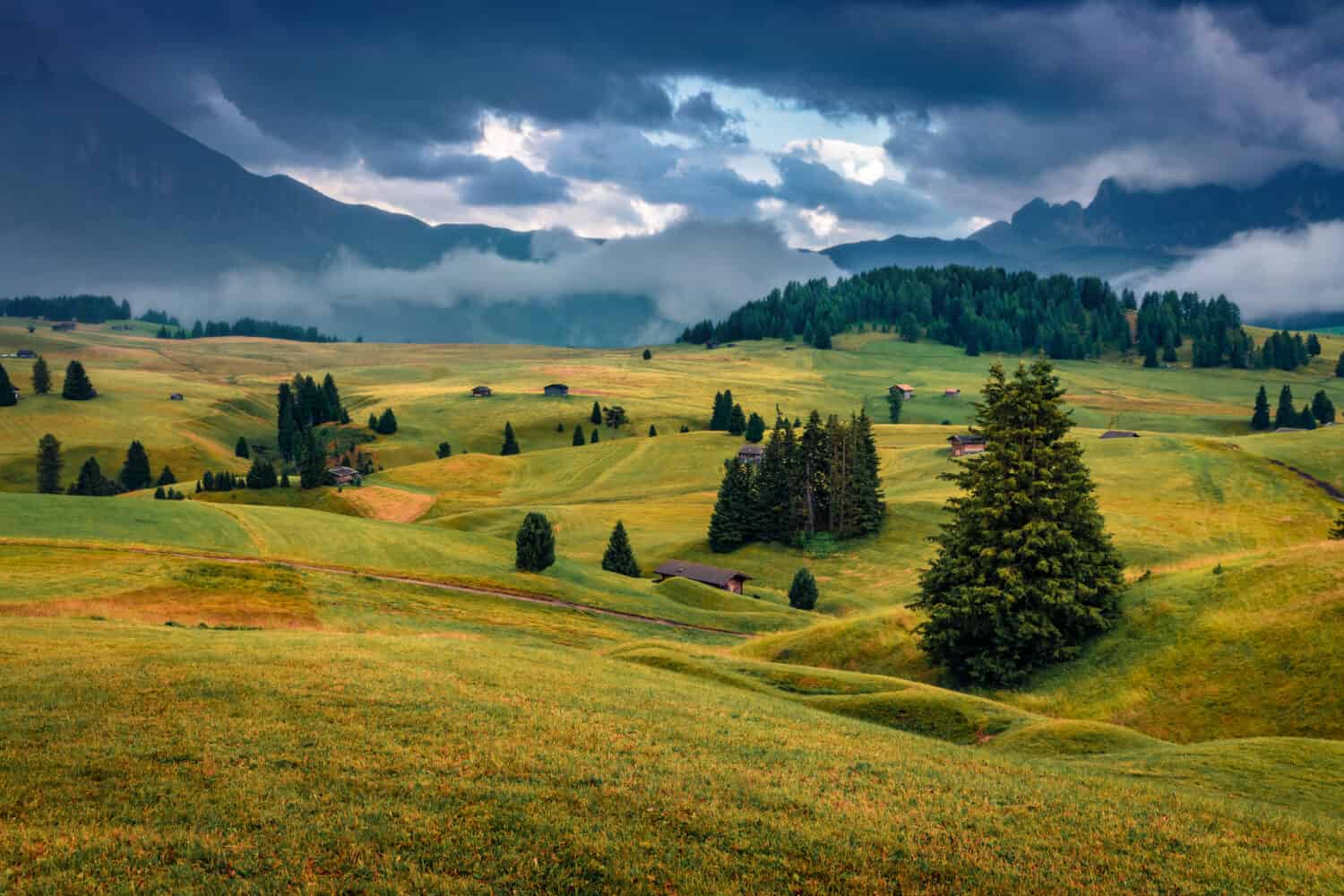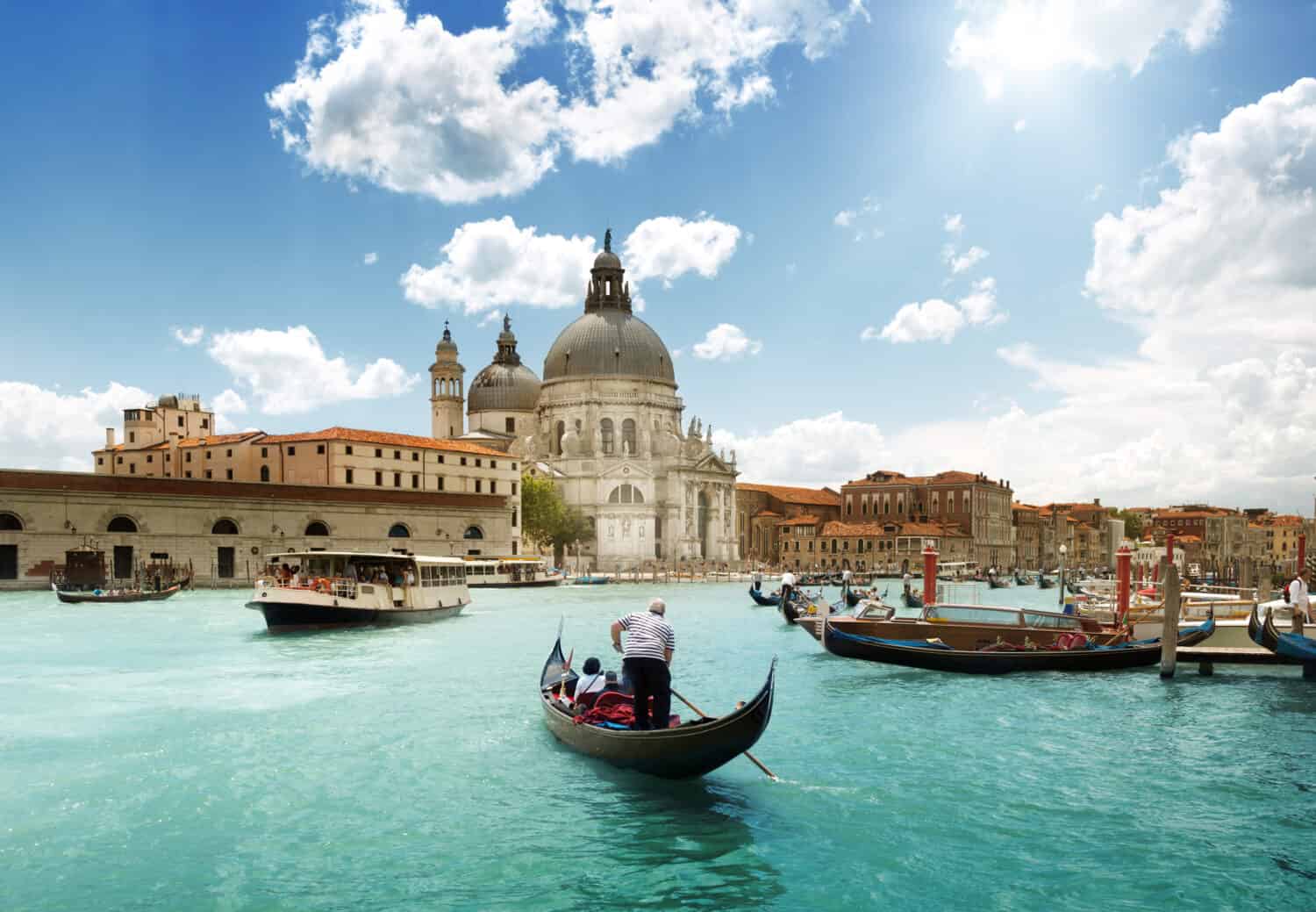Italy’s August weather is characterized by warm temperatures, abundant sunshine, and minimal rainfall, making it an ideal time to visit this beautiful Mediterranean country. As the peak of summer, August offers a delightful blend of favorable conditions for outdoor activities, beach vacations, and exploring Italy’s cultural treasures. In this article, we will explore the average weather in Italy during August, including the nuances of weather in Italy based on individual regions, weather-related records, and natural disasters.

Italy is filled with popular summer destinations for residents and tourists alike.
©Mitzo/Shutterstock.com
Italy’s Average August Weather
Temperature
During August, Italy experiences pleasant to hot temperatures throughout the country, with variations depending on the region. August is considered one of the hottest months in Italy, alongside July. The northern part of Italy, including some of the most populated cities like Milan and Turin, generally tends to have cooler temperatures than the southern regions. On average, daytime temperatures in the northern region range from 18 to 30 degrees Celsius (65 to 85 degrees Fahrenheit). The central region averages 21 to 32 degrees Celsius (70 to 90 degrees Fahrenheit). And finally, in the southern region, it ranges from 26 to 32 degrees Celsius (80-90 degrees Fahrenheit). Overall, across Italy, the daytime temperature ranges from the mid-20s to the low 30s degrees Celsius (70s to 90s degrees Fahrenheit), depending on your exact location. However, temperatures can reach well above 38 degrees Celsius (100 degrees Fahrenheit), particularly in the southern region.
Precipitation
August in Italy has low precipitation levels, with many regions experiencing minimal rainfall. The majority of the country enjoys dry conditions, offering people ample opportunities to explore the cities, countryside, and coastlines without the inconvenience of rain showers. However, some northern regions, particularly the mountainous areas, might experience occasional thunderstorms or brief showers. These events are usually localized and pass quickly, allowing for continued outdoor activities.
Wind
Wind speeds in Italy during August are generally calm to moderate, providing a pleasant breeze that helps mitigate the summer heat. Coastal areas, such as the Amalfi Coast and the Italian Riviera, benefit from refreshing sea breezes that offer respite from the warmer temperatures. Inland regions may experience slightly stronger winds, particularly in elevated areas or near mountain ranges. Additionally, coastal regions occasionally experience the sirocco, a hot and dusty wind originating from the Sahara Desert. The sirocco can bring dry and hazy conditions.
Storms
While storms are uncommon in August on the whole, some localized thunderstorms can occur in central or northern regions. These storms are typically short-lived and localized, often dissipating quickly. They may bring temporary relief from the heat and add a dramatic touch to the summer landscape. Thunderstorms are most common in mountainous areas in the northern regions, where the convergence of warm and cool air masses can trigger convective activity.
Cloud Cover and Sunshine
For Italy’s August weather, the country enjoys abundant sunshine, with long days and clear skies prevailing across the country. Cloud cover tends to be minimal, allowing people to soak up the sun and make the most of their outdoor activities while avoiding high noon heat.
Ocean Temperature
The coastal waters surrounding Italy are pleasantly warm in August, making it an ideal time for swimming, water sports, and beach activities. The average sea temperatures range from roughly 21 to 29 degrees Celsius (roughly 70 to 85 degrees Fahrenheit), depending on the location. The Adriatic Sea on the east coast and the Tyrrhenian Sea on the west coast offer delightful conditions for those seeking a refreshing dip or simply basking in the sun.
Overall, August in Italy provides a delightful combination of hot daytime temperatures, pleasant nighttime temperatures, minimal rainfall, abundant sunshine, and enjoyable ocean temperatures. Whether exploring the captivating cities, lounging on the pristine beaches, exploring national parks, or indulging in the stunning landscapes, August offers a fantastic opportunity to experience Italy’s diverse and enchanting beauty.

August weather in Italy may be hot, but it is also filled with stunning beauty.
©Andrew Mayovskyy/Shutterstock.com
Humidity and Heat Waves in Italy
Heat Waves
Most common in the summer months, heat waves occur most intensely in central and southern regions. Heat waves are prolonged periods of exceptionally hot weather characterized by high temperatures and reduced air circulation. These events can bring intense heat and discomfort, requiring extra precautions to ensure personal well-being.
During a heat wave, temperatures can soar, reaching well above the average for the season. In central and southern Italy, temperatures may climb into the high 30s to low 40s degrees Celsius (around 90s to 100s degrees Fahrenheit). It’s important to note that heat waves can be infrequent, and not every summer in Italy experiences such extreme conditions.
Italian communities and infrastructure are accustomed to hot summers and are well-prepared to cope with heat waves. Many accommodations, restaurants, and public spaces provide air conditioning or natural shade to offer respite from the scorching temperatures. It’s advisable to plan outdoor activities during the cooler parts of the day, such as mornings or evenings when temperatures are milder.
During a heat wave, staying hydrated is crucial by drinking plenty of water and avoiding prolonged exposure to direct sunlight. Wearing lightweight, breathable clothing and using sunscreen to protect the skin from harmful UV rays is also essential. Additionally, taking breaks in shaded areas, using fans or air conditioning, and seeking cooler indoor environments can help mitigate the effects of the heat.
Local authorities and health organizations often issue advisories and guidelines during heat waves. This is to ensure the well-being of residents and visitors. It’s recommended to stay informed about weather forecasts and follow any instructions or recommendations provided by local authorities. Always prioritize personal health and safety.
Humidity
Italy’s August weather experiences significant humidity. However, the country experiences varying levels of humidity across its regions. Overall, humidity tends to be high.
Along the coastal regions, such as the Amalfi Coast or the Italian Riviera, humidity can be moderately high. Especially so during the early morning and evening hours. This coastal humidity is often accompanied by refreshing sea breezes. This can provide some relief from the heat and helps maintain a pleasant atmosphere. Inland cities and regions, such as Florence or the Tuscan countryside, typically have slightly lower humidity compared to the coastal areas. However, it’s important to note that during hot spells or heat waves, the humidity levels may increase, contributing to a muggy feeling. Even the northern region, such as the Alps, experiences humidity amongst its cooler temperatures.
High humidity can make the temperatures feel hotter than they are. This is due to the moisture in the air affecting the body’s ability to cool down through perspiration. It’s advisable to stay hydrated and seek shade or air-conditioned environments when the humidity levels are high. Particularly during the hottest parts of the day.

The northern region of Italy tends to be the coolest in temperature. During August, the mountainous regions can dip to roughly 4.5 degrees Celcius (40 degrees Fahrenheit). Sometimes even lower.
©PositiveTravelArt/Shutterstock.com
Record Temperatures in Italy
In August, Italy experienced notable temperature records and rainfall. Let’s explore some of the highest and lowest temperatures ever recorded in August and rainfall occurrences.
One of the highest temperatures on record for August in Italy was registered in Sicily. This occurred on August 11, 2021, in the town of Floridia, located in the Sicilian province of Syracuse. During that sweltering day, it reached a record temperature of 48.8 degrees Celsius (119.8 degrees Fahrenheit). This record-breaking heatwave was part of a broader extreme weather event that affected various parts of Europe.
On the other end of the spectrum, though it’s difficult to pinpoint the coldest temperature recorded in August, the coolest temperatures generally occur in the Italian Alps. In the Alpine town of Livigno, for example, the temperature regularly drops 4.5 degrees Celcius (40 degrees Fahrenheit) throughout the summer. It’s important to note that low temperatures are exceptional for August and are mainly isolated to the mountainous areas.

Though not the most common month to occur, the central and northern regions of Italy can experience storms and flash flooding during August.
©Andrew Mayovskyy/Shutterstock.com
Rainfall in Italy
Amongst Italy’s August weather, the country is known to have little rainfall. However, the average rainfall across Italy varies depending on the region and time of year. Similar to Greece, Italy experiences a Mediterranean climate characterized by mild, wet winters and hot, dry summers.
In general, the northern regions of Italy receive more rainfall compared to the central and southern parts of the country. The mountainous areas, such as the Alps and the Apennines, contribute to the increased precipitation levels in the north. Cities in northern regions experience a higher average annual rainfall compared to towns in the central and southern parts of Italy.
Northern Italy
On average, the northern regions of Italy receive around 800 to 1,200 millimeters (31 to 47 inches) of rainfall annually. Some areas can receive upwards of 2,500 millimeters (98.5 inches). The general average translates to an average monthly rainfall of approximately 60 to 100 millimeters (2.4 to 3.9 inches). The rainfall in the north is relatively evenly distributed throughout the year. Higher precipitation occurs in the spring and autumn months.
Central Italy
Moving towards central Italy, including cities like Rome and Florence, the average annual rainfall decreases. In these regions, the average annual rainfall ranges from about 600 to 900 millimeters (24 to 35 inches). Monthly averages can vary from 40 to 80 millimeters (1.6 to 3.1 inches). The wetter period is during the autumn months.
Southern Italy
The southern parts of Italy, such as Naples and Sicily, experience a Mediterranean climate with drier summers. The average annual rainfall in these regions ranges from approximately 400 to 700 millimeters (16 to 28 inches). Monthly averages can range from 20 to 60 millimeters (0.8 to 2.4 inches). The wettest period occurs during autumn and the driest during summer.
It’s important to note that these are average figures, and actual rainfall patterns can vary from year to year. Like many other regions, Italy can experience precipitation variations due to climate oscillations. This could include El Niño or La Niña, as well as other atmospheric and oceanic factors.
On the whole, Italy receives the least amount of rain during the summer months, particularly in August. Areas within the southern region can receive as little as 0.5 millimeters (0.02 inches) of rainfall throughout the entire month. At the same time, areas in the northern region can receive up to 203 to 280 millimeters (8 to 11 inches) of rainfall.

Venice is a popular city to visit in Italy during the summer months.
©ESB Professional/Shutterstock.com
Natural Disasters in Italy
Italy’s August weather is generally not prone to severe natural disasters. However, like any country, Italy is not entirely immune to unexpected events that can occur.
Thunderstorms and Flash Flooding
While August is known for its warm and dry weather, some central and northern regions of Italy may experience localized thunderstorms during this time. These thunderstorms can bring heavy rainfall, strong winds, and occasional lightning. They can cause flash flooding, which tends to be the biggest concern during such storms. These storms are typically short-lived and localized, affecting specific areas rather than the entire country.
Wildfires
Italy is susceptible to wildfires from June through August during the hot and dry summer months. The combination of high temperatures, dry vegetation, and occasional strong winds can create ideal conditions for the outbreak and spread of wildfires.
August is a critical period for wildfires due to the accumulation of dry vegetation over the summer. Factors such as lightning strikes, human activities, arson, or even negligence. These factors can spark fires that rapidly spread across forests, grasslands, and rural areas. The regions most affected by wildfires tend to be central and southern Italy, where vegetation is typically drier.
Italy has established well-organized firefighting units to combat wildfires. These units include the Vigili del Fuoco (Fire Department), forest rangers, and civil protection teams. These agencies work diligently to prevent and control wildfires, utilizing aerial firefighting resources, ground crews, and efficient coordination between different entities.
Earthquakes
Italy lies in a seismically active region, and earthquakes can occur at any time of the year, including August. Italy has experienced significant seismic events throughout its history. The Apennine mountain range, which runs through the country, is an area of high seismic activity.
August is a reminder that earthquakes can strike without warning. Earthquakes can cause widespread destruction, loss of life, and infrastructure damage. In terms of the worst natural disaster on record to occur in Italy during August, one earthquake stands out. Italy witnessed the devastating effects of the tragic earthquake that struck the central region on August 24, 2016, near the town of Amatrice. The earthquake, measuring a magnitude of 6.2, caused widespread destruction and claimed the lives of hundreds of people. This tragic event serves as a reminder of the unpredictable nature of earthquakes and their potential impact on communities.
Italy has implemented rigorous building codes and seismic regulations to mitigate the impact of earthquakes. These measures aim to ensure the structural integrity of buildings and improve resilience in earthquake-prone areas. Additionally, Italy’s scientific community continues to conduct research and monitoring to enhance understanding and preparedness for seismic events.
Throughout the Year
Italy, a country with diverse geography, is susceptible to various natural hazards throughout the year. These hazards include earthquakes, wildfires, volcanic activity, landslides, and floods.
It is important to note that Italy has implemented robust infrastructure and emergency response systems to mitigate and respond to natural disasters. These systems aim to minimize the impact of such events on the population and provide timely assistance to affected areas.

Though hot and humid, August can be an enjoyable month to explore Italy.
©DaLiu/Shutterstock.com
Conclusion
Italy’s August weather beckons with warm temperatures, abundant sunshine, and minimal rainfall. Italy has pleasant daytime temperatures ranging from the mid-20s to low 30s degrees Celsius (mid-70s to low 90s degrees Fahrenheit). It’s an ideal time for seeking refuge from the hot sun by enjoying beachside and shaded activities. Coastal regions benefit from refreshing sea breezes, while localized thunderstorms may occur, mainly in the northern regions, although infrequent. Humidity levels can be moderately high, particularly during the early morning and evening hours. However, pleasant sea breezes can accompany this. The further inland and north you go, the lower the humidity levels are compared to the coast. Finally, there is a slight risk of natural disasters during this time, such as wildfires and earthquakes. Overall, the occurrence is generally low compared to other months.
Thank you for reading! Have some feedback for us? Contact the AZ Animals editorial team.







